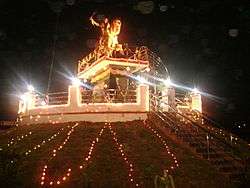Kittur
Kittur, also known as Kitturu and historically as Kittoor, is a taluka in the Belgaum district of the Indian state of Karnataka. It was part of Bailhongal taluka but was declared as an independent taluka on 23 October 2012 by the Chief Minister of Karnataka on the inauguration of Kittur Utsav. It is 177th Taluk of Karnataka State. It is a place of historical importance because of the armed rebellion of Kittur Chennamma (1778–1829), Rani of the State of Kittur against the British East India Company, during which a British Commissioner, St John Thackeray was killed.
Kittur Kitturu | |
|---|---|
Taluk | |
 | |
 Kittur Location in Karnataka, India  Kittur Kittur (India) | |
| Coordinates: 15.60°N 74.90°E | |
| Country | |
| State | Karnataka |
| District | Belgaum |
| Government | |
| • Type | Panchayat raj |
| • Body | Gram panchayat |
| Demonym(s) | Kitturunivaru |
| Language | |
| • Official | Kannada |
| Time zone | UTC+5:30 (IST) |
| PIN | 591115 |
| ISO 3166 code | IN-KA |
| Vehicle registration | KA-24 |
| Nearest city | Belgaum |
| Website | karnataka |
History
On the outskirts of the town lie the ruins of the palace within a fort. The palace was the residence of the Rani Chennamma.
In the 18th century, Kittur was ruled by the Marathas, until the Third Anglo-Maratha War, when it came under British suzerainty.[1]
Kittur was ruled by Mallasaraja in the early 19th century. His only son predeceased him, and subsequently, he was succeeded by his wife, Queen Chennamma.
In connection with a disputed succession to this chiefship in 1824, St John Thackeray, Commissioner of Dharwad, was killed in a battle when approaching the Kittur fort. Later another unit stormed Kittur and captured Queen Chennamma, who was imprisoned in Bailhongal Jail where she died. Rani Chennamma became a legend.
Her death was followed by subsequent revolts by her general Rayanna, who was also considered a hero, destroying many British officers and records. He was later hanged in 1831.
The town lends its name to the fictitious coastal town (Belgaum District has no coast, which rules out the real Kittur being the setting) 2008 novel Between the Assassinations by Aravind Adiga
See also
- Rani Chennamma
- St John Thackeray attack on Kittur
- Belgaum
- Bailhongal
References
- Chitnis, Krishnaji Nageshrao (1 January 1994). Glimpses of Maratha Socio-economic History. Atlantic Publishers & Dist. ISBN 9788171563470.
External links
![]()